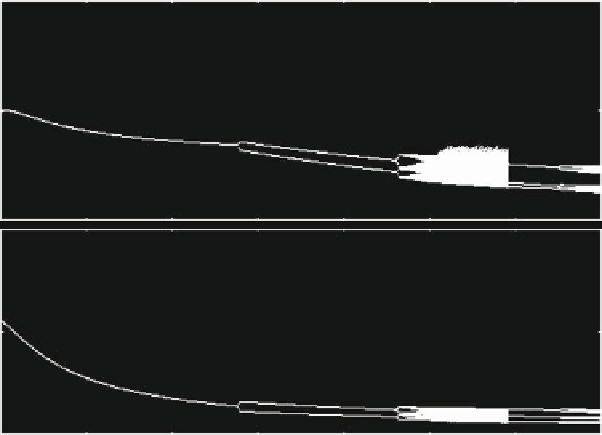Chemistry Reference
In-Depth Information
0.8
x
2
0
0.6
x
1
0
2
6
10
14
18
22
26
N
30
Fig. 4.20
Example 4.15; the discrete time oligopoly under partial cooperation - the semi-
symmetric case. Bifurcation diagrams of outputs with respect to the number of firms N.Here
A
D
16, a
1
D
0:4, a
2
D
0:3, c
1
D
5, c
2
D
6, L
1
D
L
2
D
2 and
D
0:5
in the case of non-identical cooperation levels, it is not clear if this property holds
when cooperation levels
1
and
2
differ.
The dynamic behavior of the model with partial cooperation and identical coop-
eration levels is the same as the dynamical behavior of the model considered in
Example 3.4, since the former can be obtained by the latter by just replacing the
parameter A with A.1
/. From this property we can easily deduce that the
stability condition (3.15), obtained for the semi-symmetric case with no coopera-
tion, also holds for the model with partial cooperation with identical cooperation
levels, since this stability condition is independent of the parameter A. Moreover,
as numerical explorations suggest, the same statement holds even for the stabil-
ity of periodic cycles. To illustrate this fact, in Fig. 4.20, obtained with parameters
A
D
16, a
1
D
0:4, a
2
D
0:3, c
1
D
5, c
2
D
6, L
1
D
L
2
D
2 and
D
0:5,weshow
bifurcations that occur as the number of firms increases. A simple comparison with
Fig. 3.6, which has been obtained for the same set of parameters but without coop-
eration, shows that the losses in stability occur at the same values of the bifurcation
parameter.
The bifurcation diagram in Fig. 4.21 shows the effect of changes in the levels of
cooperation
k
on the stability of the positive equilibrium and the kind of asymptotic
dynamics that can occur. Here the parameter
2
is taken as a bifurcation parame-
ter and N
D
6, a
1
D
0:5, a
2
D
0:4;
1
D
0:5. All the other parameters have
the same values as in Fig. 4.20. In this case we can see that the equilibrium loses

Search WWH ::

Custom Search